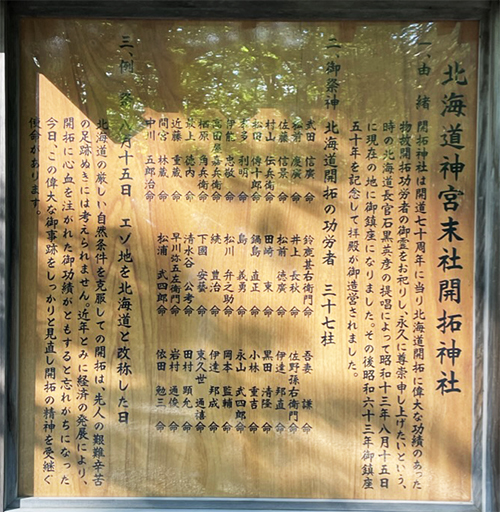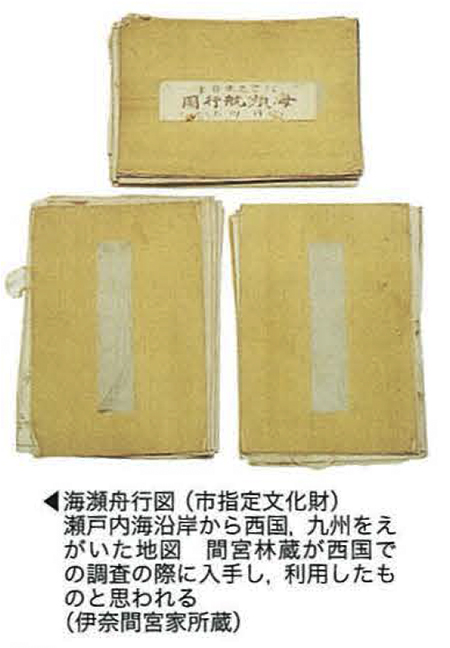


北海道・樺太の探索によって北辺の領土確定という国事に功をなした間宮林蔵。上の写真2枚はわたしの毎日の散歩道コース・参拝社である「開拓神社」(北海道神宮の末社)。ここでは北海道の現在のありようを規定した功績のあった人物37人の御柱が祀られている。間宮は上段の左から2人目に上げられている。
ほかには高田屋嘉兵衛や伊能忠敬、松浦武四郎、最上徳内などの名前が記される。知らず知らず、こうした人物名とその事跡には強い興味を持ち続けているのは、毎日のこういう習慣が大きく深層心理に染み込んでいるのかも知れない。
このように永く顕彰されている間宮だけれど、後半生は幕吏としての立場に立っての事跡が知られている。ひとつが国禁とされていた日本地図を国外に持ち出したことで多くの幕臣とシーボルトが罰せられた「シーボルト事件」でのかれの行動。今日であれば、地図情報が国禁にされていたということの方が意味不明となるけれど、専制権力体制下である幕府機構としてはきわめて秘匿性の高い情報。国家主権の根幹に関わる事象だった。歴史性を強く帯びざるを得ないことがらだと言える。
北辺の国境線についての情報を幕吏として、いわば公益に資するものとして幕府にもたらしたことで、かれの立場は幕府内で強くなったことだろう。そういうなかで政治的に幕府の方針に従う行動を取るのは自然なのだろう。シーボルトから送られてきた書簡や小包を開封せずに幕府に提出して「異人に対して私的に交流することは国禁を冒すことになる」姿勢を示したと言われる。その結果、シーボルトに対して日本地図情報を提供した同輩幕吏の高橋景保は逮捕処刑され、シーボルトは国外追放処分を受ける。
その後のかれは「幕府隠密」活動の事跡を残している。晩年には西国大名への密偵活動が知られている。シーボルト事件は1828年でかれは49歳。そこから1844年65歳で江戸の自宅で死去するまでの時間に相当する。情報というものへの態度が歴史的に政治情勢で変動した。その狭間で起こり得た事象なのか。ちょうど時代は幕末の政治動乱期に突入していく。
しかしこういう背景事実もあるけれど、国外追放されたシーボルトはヨーロッパ世界に日本の北方域の地図を発表したとき「間宮海峡」と明確に紹介している。そもそもシーボルト自身もオランダ商館員という立場を持った情報工作員であったことも事実。
そういった立場としてシーボルトは間宮に対して、特段の感情を持っていたとは言えないだろう。むしろある種のリスペクトは持っていたに違いない。国際的な立場の違いだとも思える。後世の人間にはこうした行動への判断はしにくい。
English version⬇
Rinzo Mamiya’s Birthplace – 10
Rinzo Mamiya lived as a shogunate official from the Siebold Affair to his covert activities. However, he was later enshrined as a mihashira at the Kaitakushi Shrine. The…
Rinzo Mamiya, who made a great contribution to national affairs by exploring Hokkaido and Sakhalin to determine the territory of the northern part of Japan. The two photos above are of the Kaitakushi Shrine (a branch of the Hokkaido Shrine), which is my daily walking route and shrine. The shrine enshrines the 37 Gobashira, or “pillars,” of the people who made Hokkaido what it is today. Mamiya is the second person from the left in the upper row.
Other names on the shrine include those of Kahei Takataya, Tadataka Ino, Takeshiro Matsuura, Tokunai Mogami, and others. Perhaps it is because of this daily habit that I have always had a strong interest in the names of these people and their legacies, without even realizing it.
Although Mamiya has been honored for a long time in this way, his achievements in the latter half of his life as a shogunate official are well known. One example is his actions during the Siebold Incident, in which many shogunate officials and Siebold were punished for taking a map of Japan out of the country, which had been banned by the government. Today, it would be more meaningless to say that the map information was prohibited by the government, but it was highly confidential information for the Shogunate organization under the tyrannical power system. It was an event that involved the very foundation of the nation’s sovereignty. It can be said that this information has a strong historical significance.
As a bakufu official, he brought information about the northern border to the shogunate as something that would contribute to the public interest, and this must have strengthened his position within the shogunate. Under such circumstances, it was natural for him to act politically in accordance with the policies of the shogunate. It is said that he submitted letters and packages sent by Siebold to the Bakufu without opening them to show that “to communicate privately with a foreigner would be to violate the national prohibition. As a result, Takahashi Kageyasu, a fellow shogunate official who provided Siebold with information on Japanese maps, was arrested and executed, and Siebold was deported.
After that, he left traces of his “Shogunate covert” activities. In his later years, he was known to spy on the feudal lords of western Japan. The Siebold affair took place in 1828, when he was 49 years old. This corresponds to the time from 1828 to his death in 1844 at the age of 65 at his home in Edo. Attitudes toward information have historically fluctuated in political situations. Could this be an event that could have occurred in the intervening time? The period was just entering the period of political upheaval at the end of the Tokugawa Shogunate.
However, despite this background fact, when Siebold, who was exiled from Japan, presented a map of the northern area of Japan to the European world, he clearly introduced it as the “Straits of Mamiya”. It is also a fact that Siebold himself was an information agent with a position as a member of the Dutch trading post.
As such, it cannot be said that Siebold had any particular feelings toward Mamiya. Rather, he must have had a certain respect for him. It seems to me that this is a difference in international standing. It is difficult for future generations to judge such behavior.
Posted on 5月 25th, 2023 by 三木 奎吾
Filed under: 歴史探訪







コメントを投稿
「※誹謗中傷や、悪意のある書き込み、営利目的などのコメントを防ぐために、投稿された全てのコメントは一時的に保留されますのでご了承ください。」
You must be logged in to post a comment.